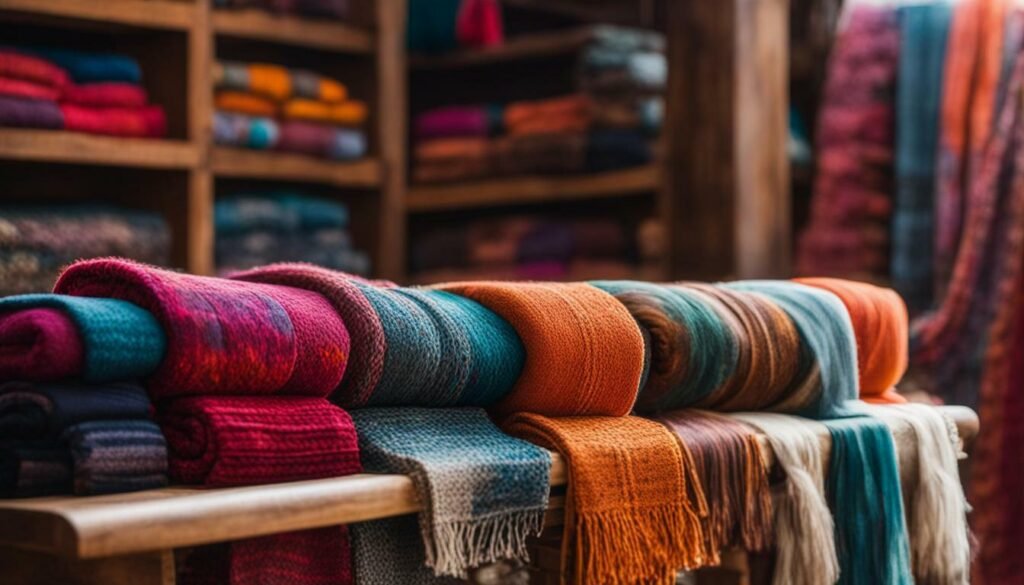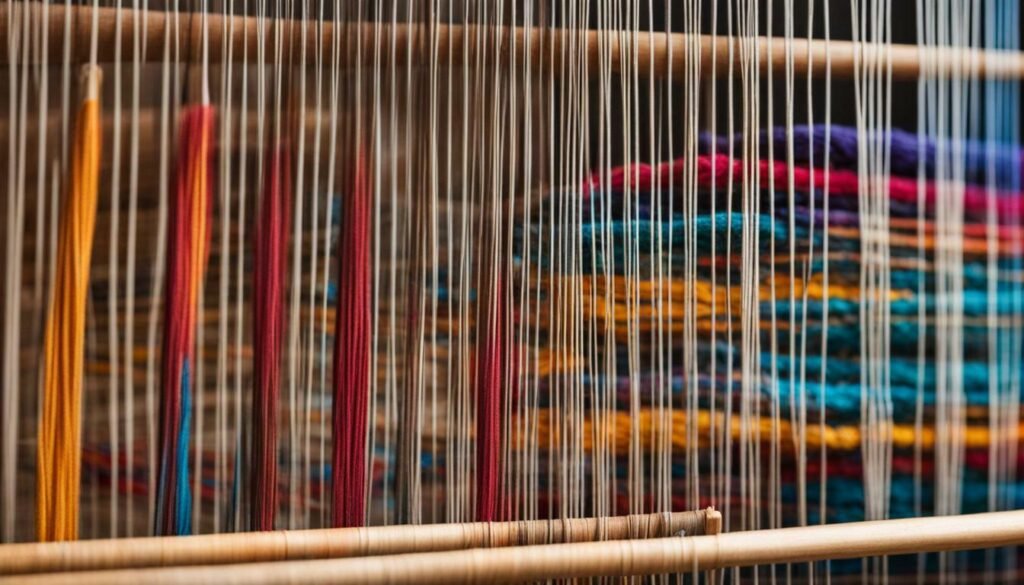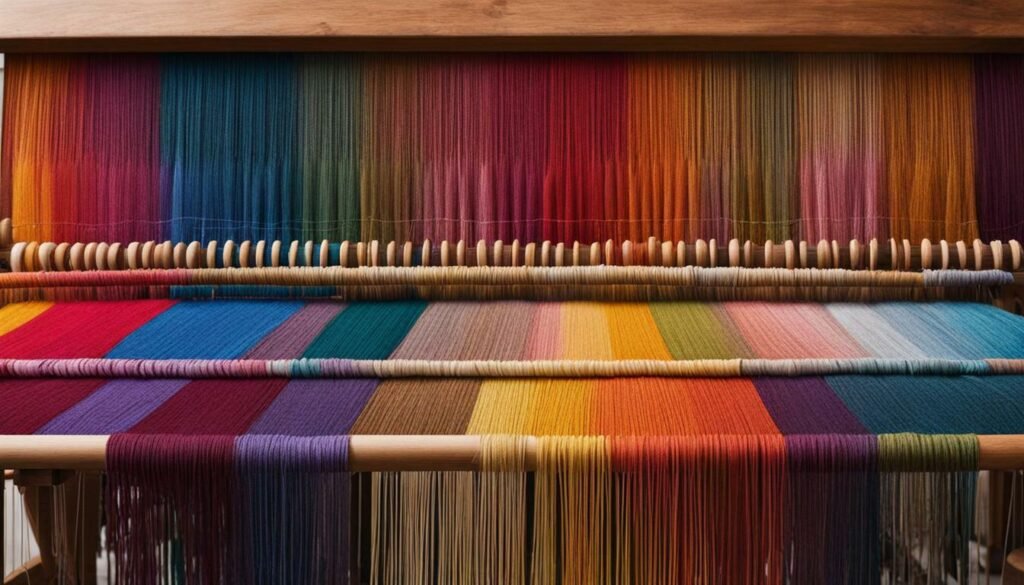Ready to explore the world of weaving? Weaving loom projects offer a fantastic opportunity to unleash your creativity and create beautiful, personalized artwork.
This comprehensive guide provides everything you need to know about weaving loom projects, from the basics of weaving looms and essential tools and materials to advanced weaving techniques and project ideas for home decor, fashion, gifts, and more.

Key Takeaways
- Weaving loom projects offer a fantastic opportunity to unleash your creativity and create beautiful, personalized artwork.
- Whether you’re a beginner or an experienced crafter, there’s always something new to learn and discover in the incredible world of weaving.
- This comprehensive guide provides everything you need to know about weaving loom projects, including the basics of weaving looms, essential tools and materials, advanced weaving techniques, and project ideas for home decor, fashion, gifts, and more.
- Get ready to explore the magical world of weaving loom projects and unleash your inner artist!

Getting Started with Weaving Looms
Welcome to the exciting world of weaving! If you’re new to weaving loom projects, it’s important to start with the basics. First, choose the type of weaving loom that best suits your needs. Some popular options for beginner weaving projects include frame looms, rigid heddle looms, and tapestry looms.
Next, gather the essential tools and materials. You’ll need a weaving shuttle, yarn, warp thread, and a beater. You may also want to invest in a weaving comb or pick, which can help with tension and weaving variations.
Setting up your loom may seem daunting at first, but it’s a crucial step that will determine the outcome of your project. Follow the manufacturer’s instructions carefully and take the time to understand the process. Once your loom is set up, it’s time to start weaving!
If you’re new to weaving, start with a simple project such as a coaster or a wall hanging. You can find many beginner weaving project ideas and weaving tutorials online to help you get started. Don’t be afraid to experiment and try new techniques. Weaving is a versatile and rewarding art form that allows you to express your creativity in countless ways.
Weaving Techniques for Beginners
Now that you have your loom set up and ready to go, it’s time to learn some basic weaving techniques. In this section, we’ll explore essential techniques such as:
- Plain weave
- Twill weave
- Basket weave
These techniques will allow you to create different textures, patterns, and designs using your loom. Here’s a brief overview of each:
Plain weave
Plain weave is the most basic and commonly used weaving technique. It involves interlacing the weft thread over and under the warp thread, alternating each row. This creates a simple and sturdy fabric, with the same pattern on both sides.
Twill weave
Twill weave creates a diagonal pattern in the fabric, and is commonly used for denim, herringbone, and chevron designs. To weave a twill, you will interlace the weft thread over two or more warp threads, before passing under one or more warp threads. Then, in the next row, you will shift the over and under pattern by one or more threads, creating the diagonal effect.
Basket weave
Basket weave creates a checkerboard pattern in the fabric and is useful for adding texture to your projects. To weave a basket weave, you will group two or more adjacent warp threads together, and then pass the weft thread over and under the grouped warp threads, alternating groups with each row. This creates a crisscross effect and can be used to create a variety of patterns.
Practice these techniques on your loom, experimenting with different thread colors, textures, and thread tensions. With each project, you’ll gain more confidence and skill in the art of weaving!

Looking for beginner weaving projects to practice your newly acquired skills? Below are some easy weaving loom projects that are perfect for beginners:
- Create a simple wall hanging with colorful yarns and tassels
- Weave a set of customized coasters for your coffee table
- Make a trendy tote bag with sturdy cotton or wool threads
- Create a cozy scarf with soft and warm alpaca or merino wool
These projects are ideal for honing your weaving techniques while creating beautiful and functional pieces that you can proudly display or gift to loved ones. For step-by-step instructions and weaving patterns, check out beginner-friendly weaving books and online tutorials.

Get creative with your weaving loom projects by experimenting with different colors, textures, and patterns. The possibilities are endless!
Weaving Loom Projects for Home Decor
Bring a touch of handmade charm to your home decor with these weaving loom projects. From stylish throw pillows and table runners to unique wall art and plant hangers, you can easily elevate your living space with personalized pieces. Here are some ideas to get you started:
- Create a woven wall hanging using natural fibers and yarns in earthy tones. Use a simple plain weave or experiment with more complex patterns to achieve a unique look.
- Weave a textured table runner with a mix of thick and thin fibers in your favorite colors. Add fringe to the ends for a playful touch.
- Make a set of coasters using a small weaving loom and cotton yarn in different shades. These make great gifts for friends and family.
- Design a macrame-style plant hanger using a wooden dowel and cotton cord. Use intricate knotting techniques to create a boho-chic look.
- Weave a cozy throw blanket with soft wool or alpaca yarns. Choose a simple pattern or create a unique design by mixing different textures.

With these weaving loom projects, you can add a personal touch to your home and create a warm and inviting atmosphere. Let your creativity run wild and experiment with different fibers, colors, and patterns to achieve your desired look.
Weaving Loom Projects for Home Decor
You don’t have to be an interior designer to give your home a personal touch. With the magic of weaving, you can craft your own unique home decor pieces that reflect your personality and style. Here are some weaving loom projects that will add a handmade charm to your living space:
- A woven wall hanging incorporating your favorite colors and textures
- A cozy woven throw pillow made with soft, squishy yarn
- A stylish table runner with intricate patterns and designs
- A vertical plant hanger to add some greenery to your walls
These projects are perfect for DIY enthusiasts who love adding a personal touch to their living spaces. Use different weaving techniques and materials to create pieces that suit your home’s color palette and aesthetic. Unleash your creativity and impress your guests with your handwoven home decor.

Remember to use the keywords “weaving loom projects”, “weaving ideas”, “DIY weaving projects”, “handweaving projects”, and “weaving crafts” throughout your projects for SEO optimization.
Weaving Loom Projects for Fashion and Accessories
Why settle for store-bought accessories when you can weave your own unique pieces? With weaving loom projects for fashion and accessories, you can create stunning pieces that showcase your personal style. From colorful earrings and cozy scarves to stylish handbags and trendy headbands, the possibilities are endless.
- Learn how to mix and match different fibers and colors for a truly one-of-a-kind look.
- Experiment with weaving patterns and techniques to create unique textures and designs.
- Discover how to incorporate unconventional materials, such as leather and beads, into your weaving projects for added depth and visual interest.
With these weaving loom projects, you can show off your artistic flair and create accessories that are both fashionable and functional. So grab your loom, thread, and weaving tools, and let your creativity soar!
If you’re looking for a unique and thoughtful gift idea, why not create a handwoven masterpiece? Weaving loom projects make perfect gifts for any occasion, from birthdays to weddings and everything in between. Here are some ideas to get you started:
- Create a personalized wall hanging featuring the recipient’s favorite colors or meaningful symbols.
- Weave a set of beautiful coasters that showcase your weaving skills and the recipient’s unique style.
- Design a delicate piece of woven jewelry, such as a bracelet or necklace, using fine threads and intricate patterns.
- Braid a colorful and sturdy macrame plant hanger that will bring life and character to any room.
With a little creativity and some weaving magic, you can create gifts that will be cherished and appreciated for years to come.

Introducing weaving to kids can be a fun and interactive way to not only teach them a new skill but also foster creativity and critical thinking. Here are some weaving loom projects that are perfect for kids:
- Create a simple weaving frame using cardboard and yarn.
- Make a colorful woven bookmark using a small weaving loom.
- Weave a friendship bracelet using a simple cardboard loom and embroidery floss.
- Create a woven tapestry using a larger, more intricate weaving loom.
- Play weaving games such as “I Spy” to identify different colors and textures of yarn.
For educators, weaving can also be a great addition to the classroom to teach kids about different cultures and historical practices. Consider these weaving loom projects for educational purposes:
- Explore the cultural significance of Navajo rug weaving and create your own miniature rug using a weaving loom.
- Create a woven map to teach geography and map-making skills.
- Experiment with different weaving techniques and patterns to teach math concepts such as symmetry and pattern repetition.
- Introduce weaving as a form of social activism and create a collaborative art project with a message.
With these weaving loom projects, kids can have fun while developing their creativity and learning new skills. Educators can also incorporate weaving into different subjects to create a well-rounded learning experience.
If you’re looking for a fun and educational activity for kids, weaving on a loom is a fantastic option. Not only does it enhance their creativity and fine motor skills, but it also teaches them problem-solving skills and patience. Here are some weaving loom projects for kids and education:
- Create a simple weaving frame using cardboard and yarn. This is a great way to introduce the concept of weaving and help kids develop their coordination and concentration.
- Make a woven bookmark using a small cardboard loom and colorful yarn. This project provides a fun way to practice basic weaving techniques and create a functional item.
- Play weaving games, such as “Weave a Story”, where each person adds a sentence to a story while weaving a section of a tapestry. This project encourages collaboration, imagination, and storytelling skills.
- Create classroom-friendly projects, such as woven name tags or woven map projects that teach geography, history, and cultural diversity.
In addition to these projects, there are plenty of weaving tutorials and resources for kids and educators online. Check out weaving books, online courses, and weaving communities that offer a wealth of information and inspiration for weaving loom projects.
Overall, weaving on a loom is a rewarding and enjoyable activity for kids of all ages, and it’s a great way to introduce them to the world of fiber arts. Encourage their creativity and watch their imagination bloom with these fun weaving loom projects for kids and educational purposes.
Weaving Loom Projects: Exploring Weaving Patterns and Design Inspiration
Have you ever looked at a gorgeous piece of woven art and wondered how the weaver created such intricate patterns and designs? The possibilities of weaving patterns and design inspiration are truly endless, and in this section, we’ll give you some ideas to get started.
Where to Find Inspiration
One of the best things about weaving is that inspiration can come from almost anywhere. Here are some sources that may spark your creativity:
- Nature – Think about the colors and patterns of sunsets, flowers, foliage, and landscapes.
- Art – Look to paintings, sculptures, and other artwork for unique color palettes and design ideas.
- Fashion – Follow current fashion trends and incorporate them into your weaving projects.
- Cultural traditions – Explore traditional weaving patterns from different cultures and put your own spin on them.
Creating Your Own Patterns
If you have a specific design or motif in mind, you can create your own weaving pattern. Here’s how:
- Draw out your design on graph paper or using a digital program like Adobe Illustrator.
- Assign a color to each square or section of your design.
- Decide on the size of your project and how many warp and weft threads you’ll need.
- Set up your loom and warp it according to your design.
- Weave in the colors according to your design, either by using tabby weave or another technique.
With a little practice, you’ll be able to create intricate patterns and designs that are truly unique.
Adapting Existing Patterns
If you’re not ready to create your own pattern from scratch, you can adapt existing patterns to suit your needs. Here’s how:
- Find a pattern you like either from a book, website, or another source.
- Think about how you can modify it to suit your project. For example, you may want to change the color palette or adjust the size of the pattern.
- Draw out your modified design on graph paper or using a digital program.
- Warp your loom according to your modified design.
- Weave in the pattern using the instructions provided or adapting it according to your own preferences.
By adapting existing patterns, you can create something new and unique that still follows a tried and true design.
As you can see, the possibilities of weaving patterns and design inspiration are truly endless. Whether you’re drawing inspiration from nature or creating your own designs from scratch, weaving is a wonderful way to express your creativity and make beautiful, functional pieces of art.
Weaving Loom Projects Tips and Troubleshooting
As a weaver, it’s not uncommon to encounter challenges when creating your weaving loom projects. Here are some troubleshooting tips to ensure successful weaving.
- Warp tension: If you notice that your weaving loom project is starting to bulge, it may be a sign of uneven warp tension. To fix this, try adjusting the tension on your loom or using a warp stretcher.
- Fixing mistakes: If you make a mistake in your weaving, don’t panic! It’s often possible to carefully remove the affected section and redo it. Alternatively, you can incorporate the mistake into your design and turn it into a unique feature.
- Troubleshooting pattern design: If you’re having trouble with a particular pattern or design, try breaking it down into smaller sections and practicing each one individually. You may also want to consult online weaving tutorials or seek advice from more experienced weavers.
Remember, practice makes perfect when it comes to weaving. Don’t be afraid to experiment with different patterns, techniques, and fibers to create unique and beautiful weaving loom projects. If you need additional guidance, consider taking a weaving course or joining a weaving community to connect with other passionate weavers.
Ready to dive deeper into the world of weaving loom projects? Check out these helpful resources:
- Visit websites like Weaving Today, The Weaving Loom, and Schacht Spindle Company for weaving tutorials, patterns, and inspiration.
- Explore books such as The Weaver’s Idea Book by Jane Patrick and Learning to Weave by Deborah Chandler for in-depth weaving techniques and projects.
- Enroll in an online weaving course like Weaving 101 or The Art of Tapestry Weaving to improve your weaving skills and connect with fellow weavers.
- Join weaving communities like Ravelry and Weavolution to share your projects, ask for advice, and get feedback from other weaving enthusiasts.
- Find weaving supplies like looms, yarns, and accessories on websites such as Etsy, Webs Yarn, and Darn Good Yarn.

Are you ready to explore the exciting world of weaving loom projects? Whether you’re a beginner or an experienced weaver, there’s no better time to start your creative journey. With a wealth of weaving ideas, patterns, and techniques available, you can unleash your imagination and create beautiful, handcrafted pieces that reflect your unique vision and style.
Here are some tips to help you get started:
- Invest in a quality weaving loom and essential tools such as shuttles, bobbins, and tapestry needles.
- Choose the right fibers and materials for your project, considering factors such as texture, color, and durability.
- Practice basic weaving techniques such as plain, twill, and basket weave, and experiment with different patterns and designs.
- Start with easy projects such as coasters, wall hangings, or scarves, and gradually progress to more complex designs.
- Join a weaving community, attend workshops or online courses, and seek inspiration from other weavers to enhance your skills and knowledge.
- Enjoy the process, be patient, and have fun! Weaving is a meditative and rewarding activity that can also help reduce stress and anxiety.
By following these tips and your own creative instincts, you can create stunning weaving loom projects that reflect your artistry and passion. With a little practice and patience, who knows where your weaving journey will take you? Start today and find out!
FAQ
What are weaving loom projects?
Weaving loom projects refer to creative craft projects that involve using a weaving loom to create various items such as wall hangings, scarves, bags, and more. These projects allow you to explore different weaving techniques and patterns to create unique and personalized artwork.
Are weaving loom projects suitable for beginners?
Yes, weaving loom projects can be enjoyed by beginners. There are plenty of beginner-friendly projects that provide step-by-step instructions and guidance to help you learn the basics of weaving. With practice and patience, you can quickly progress and create more complex projects.
What materials do I need for weaving loom projects?
The materials you will need for weaving loom projects include a weaving loom, yarn or thread in various colors and textures, weaving tools such as shuttles and weaving needles, and any additional embellishments you wish to incorporate into your project.
How do I set up a weaving loom?
The setup process for a weaving loom may vary depending on the type of loom you have. Generally, you will need to follow the manufacturer’s instructions to assemble the loom, attach the warp threads, and adjust the tension. It’s important to ensure that the loom is properly set up before beginning your weaving project.
What are some popular weaving techniques?
Some popular weaving techniques include plain weave, twill weave, and basket weave. These techniques allow you to create different textures, patterns, and designs in your weaving projects. By experimenting with different techniques, you can add depth and visual interest to your creations.
Can I weave using different types of fibers?
Yes, weaving can be done using various types of fibers such as cotton, wool, silk, and even synthetic materials. Each type of fiber has its unique characteristics, which can affect the texture and appearance of your woven projects. Exploring different fibers can open up a world of possibilities in your weaving creations.
Where can I find weaving patterns?
There are many resources available online and in books where you can find weaving patterns. Websites, books, and online courses dedicated to weaving often provide a wide range of patterns suitable for different skill levels and project types. You can also create your own patterns or adapt existing ones to suit your creative vision.
What are some tips for successful weaving?
Some tips for successful weaving include maintaining consistent tension in your warp threads, starting with simpler projects as a beginner, using quality materials and tools, and taking your time to ensure accuracy in your weaving. It’s also helpful to join online communities or attend weaving workshops to learn from experienced weavers and exchange tips.
Can children participate in weaving loom projects?
Absolutely, weaving loom projects can be a great activity for children. Weaving promotes creativity, fine motor skills, and problem-solving abilities. There are weaving loom projects specifically designed for kids, using simplified techniques and kid-friendly materials. It’s a wonderful way to introduce children to the world of fiber arts.
Where can I find additional resources for weaving loom projects?
To find additional resources for weaving loom projects, you can explore websites, books, online courses, and communities dedicated to weaving. These resources provide a wealth of information, patterns, tutorials, and inspiration to further enhance your weaving skills and knowledge.
